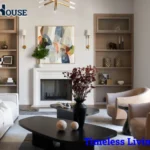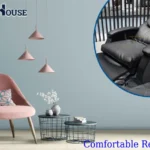Mastering the art of arranging furniture is a crucial skill for creating harmonious and functional living spaces. This comprehensive interior design masterclass will guide you through the essential principles and techniques of furniture arrangement, helping you transform any room into a well-balanced and inviting environment.
By understanding the fundamentals of space planning and implementing strategic furniture placement, you’ll be able to optimize your home’s layout and create spaces that are both aesthetically pleasing and practical.
Understanding the Basics of Furniture Arrangement
Before diving into specific techniques, it’s important to grasp the fundamental concepts that underpin successful furniture arrangement:
Balance and Proportion
Achieving visual balance is key when arranging furniture. This involves distributing the visual weight of furniture pieces evenly throughout the room. Consider the size, shape, and color of each item to create a sense of equilibrium. For example, pair a large sofa with two smaller armchairs to balance the seating area.
Focal Points
Identifying and working with focal points is crucial in arranging furniture. A focal point could be a fireplace, a large window with a view, or even a statement piece of art. Orient your furniture arrangement to highlight and complement these features. For instance, in a living room with a fireplace, position the main seating to face this natural focal point.
Traffic Flow
Ensuring smooth traffic flow is essential for a functional space. When arranging furniture, create clear pathways that allow for easy movement throughout the room. Avoid placing furniture in a way that obstructs natural walkways or creates awkward bottlenecks.

Room-Specific Furniture Arrangement Strategies
Different rooms have unique requirements when it comes to arranging furniture. Let’s explore some room-specific strategies:
Living Room Layout
The living room is often the heart of the home, where family and friends gather. When arranging furniture in this space:
- Create conversation areas by positioning seating to face each other, typically no more than 8 feet apart[1].
- Use a large area rug to anchor the seating arrangement and define the space[1].
- If possible, avoid pushing all furniture against the walls, as this can make the room feel less intimate[2].
Bedroom Arrangement
In the bedroom, the focus should be on creating a restful and functional space:
- Place the bed as the focal point, ideally facing the window and as far from the door as possible[1].
- Position nightstands of equal height on either side of the bed for balance[1].
- If space allows, include a seating area with a chair or bench at the foot of the bed[1].
Dining Room Setup
For dining rooms, the arrangement should facilitate comfortable dining and conversation:
- Center the dining table in the room, ensuring enough space for chairs to be pulled out easily.
- If using a sideboard or buffet, place it against a wall for easy access during meals.
- Consider adding a rug under the dining table to define the space, but ensure it’s large enough to accommodate chairs when pulled out.
Maximizing Space with Smart Furniture Arrangement
Arranging furniture effectively can make even small spaces feel larger and more functional:
Multifunctional Furniture
Incorporate pieces that serve multiple purposes, such as ottomans with storage or expandable dining tables. This approach to arranging furniture allows for flexibility and maximizes space efficiency[4].
Vertical Space Utilization
Don’t forget to use vertical space when arranging furniture. Tall bookcases, wall-mounted shelves, and hanging organizers can free up floor space while providing additional storage and display areas[4].
Corner Utilization
Make use of often-overlooked corners by arranging furniture such as reading nooks, corner desks, or angled entertainment centers. This strategy helps to maximize every inch of available space[2].
The Role of Lighting in Furniture Arrangement
Lighting plays a crucial role in how we perceive and use space. When arranging furniture, consider:
- Natural light sources and how furniture placement can maximize or control light exposure.
- The placement of floor and table lamps to create a layered lighting scheme.
- How overhead lighting fixtures relate to furniture groupings below.
Incorporating Color and Texture
While arranging furniture, don’t overlook the impact of color and texture:
- Use area rugs to define spaces and add texture to your furniture arrangement.
- Consider the color of your furniture in relation to wall colors and how they work together in the overall arrangement.
- Mix textures within your furniture arrangement to add depth and interest to the space.
Technology and Furniture Arrangement
In today’s digital age, technology often plays a significant role in our living spaces. When arranging furniture:
- Consider the placement of TVs, gaming consoles, and computer workstations.
- Ensure easy access to power outlets for electronic devices.
- Think about cable management to keep your furniture arrangement looking neat and organized.
Flexibility in Furniture Arrangement
Remember that arranging furniture is not a one-time task. Be open to rearranging as your needs change:
- Experiment with different layouts to find what works best for your lifestyle.
- Consider seasonal changes and how they might affect your furniture arrangement.
- Be willing to update your arrangement as you acquire new pieces or your family’s needs evolve.
The Importance of Negative Space
When arranging furniture, it’s crucial not to overlook the value of negative space:
- Allow for breathing room between furniture pieces to prevent a cluttered feel.
- Use empty space strategically to create visual balance and flow in your arrangement.
- Remember that sometimes less is more when it comes to furniture arrangement.
Arranging Furniture for Special Occasions
Consider how your furniture arrangement might need to adapt for special events:
- Plan for additional seating options that can be easily integrated when entertaining.
- Think about how your arrangement can accommodate a Christmas tree or other seasonal decor.
- Consider creating flexible spaces that can be easily rearranged for parties or gatherings.
The Impact of Architecture on Furniture Arrangement
When arranging furniture, it’s important to work with, not against, the architectural features of your space:
- Use furniture arrangement to highlight attractive architectural elements like bay windows or fireplaces.
- Be mindful of challenging features like sloped ceilings or awkward corners when planning your layout.
- Consider how built-in elements like bookcases or window seats can be incorporated into your overall furniture arrangement.
Personalizing Your Furniture Arrangement
While there are many rules and guidelines for arranging furniture, remember that your space should reflect your personal style and needs:
- Incorporate meaningful pieces into your arrangement, even if they don’t follow traditional rules.
- Create displays of personal items within your furniture arrangement to add character to the space.
- Don’t be afraid to break the rules if a particular arrangement feels right for you and your lifestyle.
By mastering these principles and techniques of arranging furniture, you’ll be well-equipped to create spaces that are not only beautiful but also perfectly tailored to your needs and lifestyle. Remember, the key to successful furniture arrangement lies in balancing aesthetics with functionality, and always being open to adjusting and refining your layout as needed.
Conclusion
Arranging furniture is an essential part of home design, allowing you to make the most of your space while ensuring comfort and functionality. Whether you are setting up a small apartment or a spacious house, thoughtful furniture placement enhances the flow of movement and creates a balanced aesthetic. By following strategic layout ideas, you can transform any room into a welcoming and organized space that suits your needs.
FAQs
- How often should I rearrange my furniture? There’s no set rule, but consider rearranging seasonally or whenever your needs change. This keeps your space fresh and allows you to adapt to new lifestyle requirements.
- What’s the biggest mistake people make when arranging furniture? One common mistake is pushing all furniture against the walls. This can make a room feel less intimate and hinder conversation. Try floating furniture away from walls to create a more inviting atmosphere.
- How can I make a small room look bigger through furniture arrangement? Use multi-functional pieces, utilize vertical space with tall bookcases, and keep pathways clear. Also, consider using lighter colors and mirrors to create the illusion of more space.
- Should I always arrange furniture symmetrically? While symmetry can create a formal, balanced look, it’s not always necessary. Asymmetrical arrangements can add interest and a more relaxed feel to a room.
- How do I arrange furniture in an open-plan space? Use area rugs, lighting, and furniture placement to define separate zones within the open space. Create distinct areas for different functions while maintaining a cohesive overall look.




